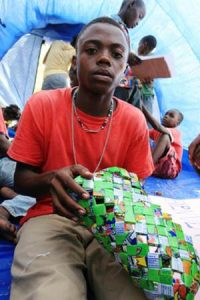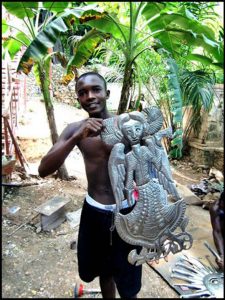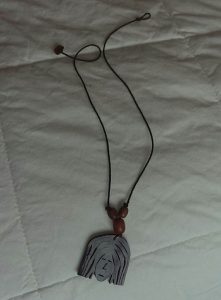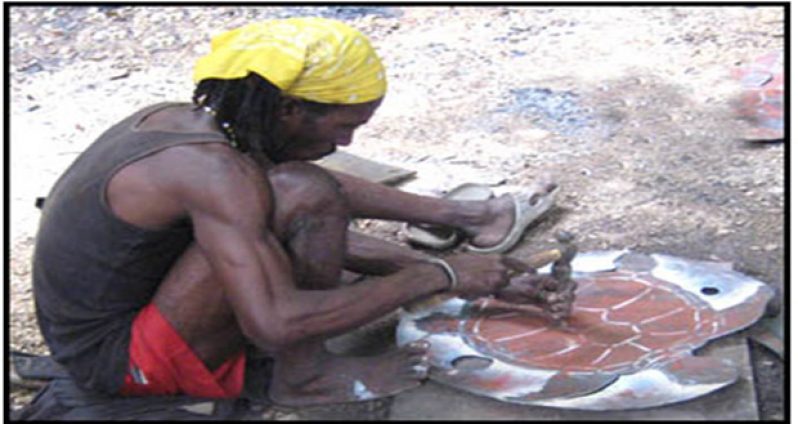THERE is an old proverb that says, “Necessity is the mother of all invention,” which translates into when the need for something becomes essential, one is forced to find ways of acquiring or achieving it.In a rapidly advancing technological world, where globalisation has shifted the traditional social and cultural orientation, the small French-speaking nation of Haiti remains one of the few countries in the western hemisphere where art revolves, primarily, around its ability to improvise and recycle.

But what exactly does this have to do with necessity paving a way for inventions in Haiti?
With a population of 10.32 million people recorded in 2013, the country has been registered by the World Bank as being the poorest in the western hemisphere. Of this amount, a figure standing just shy of 80 per cent live below the poverty line in the French-speaking nation.
This staggering level of poverty in Haiti is associated with a profile of social indicators including a low literacy rate, low life expectancy and the lack of access to potable water in most parts of the country, among others.
Trapped in the social cycle of poverty, which is nevertheless enriched by culture, the country has evidently relied heavily on the emergence of its local art to aid in the survival of its people.
The testimony of this lies in the fact that, at almost every corner in Port-au-Prince, the country’s capital and largest city, there are seemingly lower middle-class people attempting to solicit sales for paintings and/or other forms of artwork.
But what is keen to note about Haiti is that visual arts in this part of the Caribbean are not limited to drawings and paintings, although those forms dominate the very limited markets. In fact, steel, rubber and cardboard have all contributed significantly to expanding the artistic culture of the land.
Steel
One of the unique forms of art is the Haitian steel drum art. Metal drums, traditionally used for transporting oil in Haiti, or storing garbage, as people in Guyana do, have found themselves contributing to art in Haiti.
Fifty-five gallon oil drums are dissected and flattened out through the use of a hammer. Artistic designs are then sketched onto the flattened metal after which a hammer, chisel and various primitive tools are used to cut the shapes, while various decorative patterns are pounded into the metal. The finished design is signed by the artist and coated with a protective finish.
This particular art form which was birthed in Haiti in the early 1950s by a simple blacksmith, Georges Liautaud, has been used to promote domestic life and mythical creatures of the land, through their representation on these pieces.
Rubber
In Guyana, the only recreational use of car tyres apart from its intended purpose, is its use as swings and in the streets by children who skilfully steer the rolling tyres without physically touching.
In Haiti though, this “valued” piece of material has also found its way into the artistic field, used in forms which are entirely new to Caribbean culture. From its assembly to form replicated motorcycles in local parks, to swans designs in ponds across the city, the usage of tyres in Haiti is limitless.

Uniquely though, Haitians have also used this same rubber to create jewellery and symbols to represent elements of Caribbean life. One creative design which has been selling like “hot cakes” at the Caribbean Festival of Arts (CARIFESTA), currently ongoing, is a pendant taking the form of a Rastafarian head with the locks being the highlight of the design.
Cardboard
A school project or poster would most definitely need the use of a cardboard, as Guyanese know it. But for Haitians, the paper-like material serves more than just that purpose.
The story of Jeanot Dossus, a 15-year-old Haitian boy who was making bags from cardboard, was reported months ago in the media.
In a public health tent in Port-au-Prince, which was filled with children absorbed in a variety of activities Dossus sat, totally focused, and with meticulous care, he folded strips of cardboard wrapped with pieces from empty crisp packets, then weaving them into what was obviously a bag–a glorious green basket-weave bag.
He was making a variety of items from empty crisp bags, which people were collecting. The 15-year-old artist had worked out how many he had to make and what he could charge for them, to help pay for his school fees and supplies.

The poverty-stricken lad related to those around him that, “I want to improve the quality [of art],” adding that he played the drums and guitar and his dream was to be a musician.
While Haiti – plagued by natural disasters and negative stereotypical attributions – continues to build its economic and social foundation which has been fragmented since its acquisition of independence, its cultural elements, primarily visual arts, continue to contribute significantly to the country’s unique identity.
But despite attempts at pushing this artistic agenda, the lack of local and regional markets, according to local artists, has stifled growth of the sector in this regard.
But Haiti remains one of the beauties of the Caribbean; a country which has been isolated due to the language barrier, but which prides itself in the face of neglect.
By Ravin Singh in Haiti




.png)









